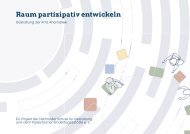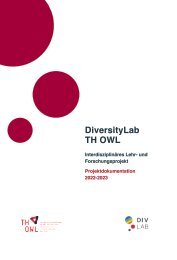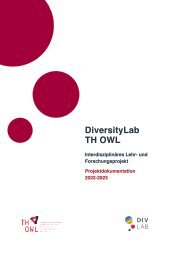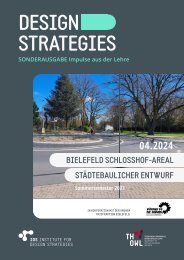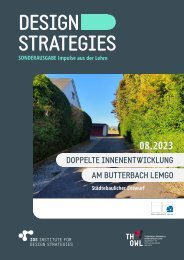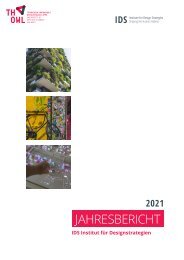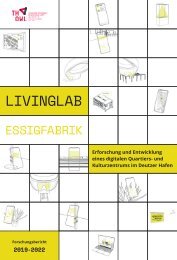Design Strategies IMPULSE - Sustainable Facades Vol 2
Report Winter Semester 2023/24
Report Winter Semester 2023/24
Create successful ePaper yourself
Turn your PDF publications into a flip-book with our unique Google optimized e-Paper software.
Figure 32. Density<br />
Figure 36. Summary of comparative analysis<br />
Figure 33. Thermal Conductivity<br />
Figure 34. Heat Capacity<br />
Figure 35. Compressive strength<br />
Figure 35. Sound reduction (dB)<br />
The U-value, expressed in W/m²K, represents<br />
the overall heat transfer coefficient of a building<br />
element or product. It‘s calculated using the<br />
equation U-value = thermal conductivity (λ) /<br />
thickness (d). This value indicates the rate at which<br />
heat is transferred through one square meter<br />
of the structure, divided by the temperature<br />
difference across the structure.<br />
Compressive strength is the strength of a<br />
material loaded in compression. For load-bearing<br />
structures (1-2 stories) a compressive strength<br />
of 0.1-0.2MPa is sufficient, but for safety reasons<br />
and after the safety factors are applied, the<br />
compressive strength should be ca. 2-2.5 MPa [2].<br />
As Fig 35 shows unfi red earthen products,<br />
rammed earth and cork present the highest values<br />
of compressive strength, while hemp lime product<br />
presents a slightly lower value of compressive<br />
strength but still a sufficient compressive strength<br />
of more than 2 MPa. On the other hand, straw<br />
products have very low values, less than 1 MPa<br />
which means they are not suitable as load-bearing<br />
materials.<br />
Fig 36 represents the sound reduction capability<br />
of the materials. From this graph, it is noticed that<br />
Rammed earth and Hemp lime products present<br />
the highest sound reduction. In a project where<br />
acoustic performance has a high priority, these<br />
materials can be a better choice.<br />
Different comparative analyses result that<br />
different materials may belong to multiple<br />
categories depending on their applications<br />
(Fig 37), each offering unique benefi ts and<br />
considerations. While biodegradable materials<br />
require careful design to avoid moisture issues,<br />
cork stands out for its water resistance, alongside<br />
stabilized earthen structures. Conversely, straw<br />
products necessitate robust water protection due<br />
to susceptibility to rot. Despite this, straw remains<br />
cost-effective and widely available, boasting<br />
favorable thermal and mechanical properties,<br />
ideal for eco-friendly construction projects.<br />
8. Conclusion<br />
This study provides valuable insights into the<br />
practical implementation of biodegradable<br />
materials in envelope design, equipping<br />
architects, engineers, and builders with informed<br />
decision-making tools. Biodegradable materials<br />
offer numerous benefits, including renewability,<br />
reduced environmental impact, and compatibility<br />
with circular economy principles,<br />
while also enhancing structural integrity and<br />
indoor environmental quality. „Building for the<br />
Future: A Guide to Biodegradable Materials<br />
in Envelope <strong>Design</strong>“ aims to inspire industry<br />
professionals and researchers to embrace<br />
these materials for a more sustainable future,<br />
leveraging advancing technology to further<br />
enhance their performance and unlock their full<br />
potential in sustainable construction endeavors.<br />
26<br />
ARTICLES<br />
<strong>Design</strong> <strong>Strategies</strong> <strong>IMPULSE</strong> – <strong>Sustainable</strong> Façades 04.2024 <strong>Design</strong> <strong>Strategies</strong> <strong>IMPULSE</strong> – <strong>Sustainable</strong> Façades 04.2024<br />
ARTICLES<br />
27





